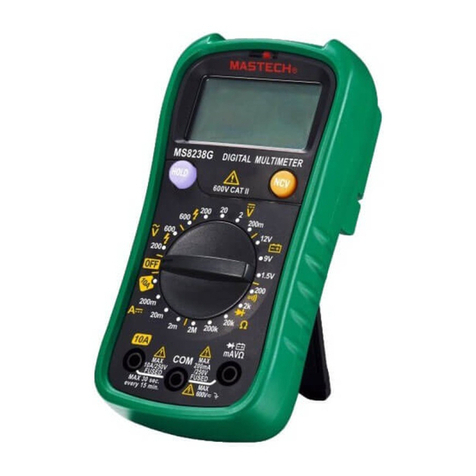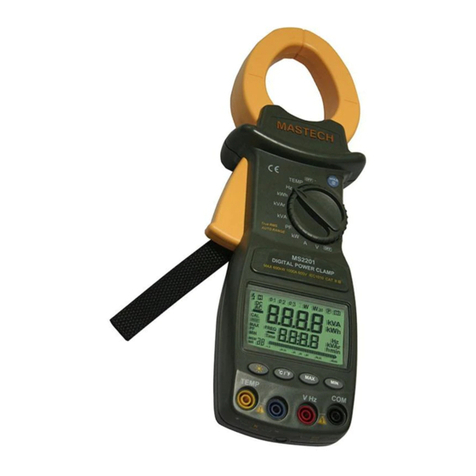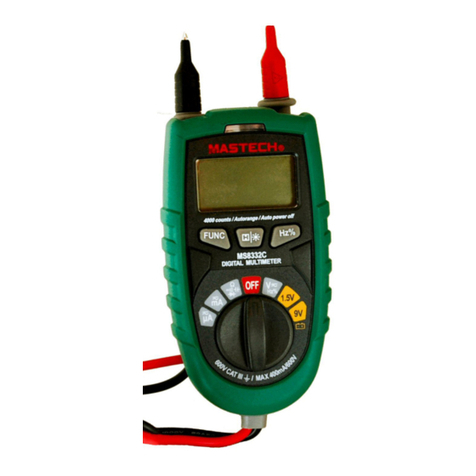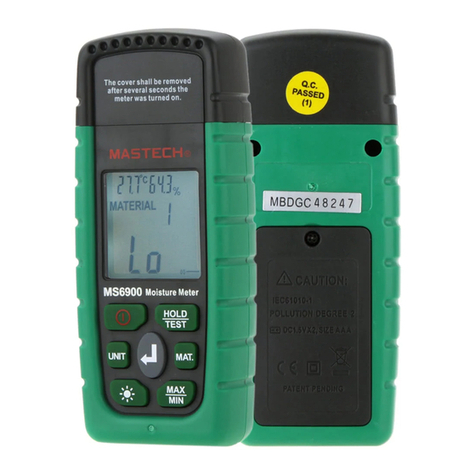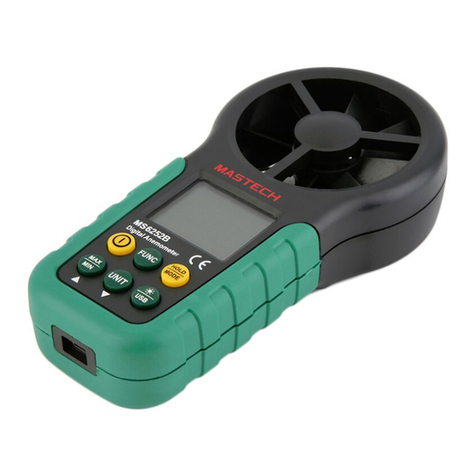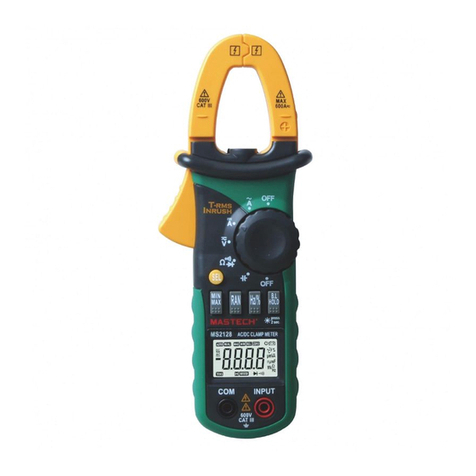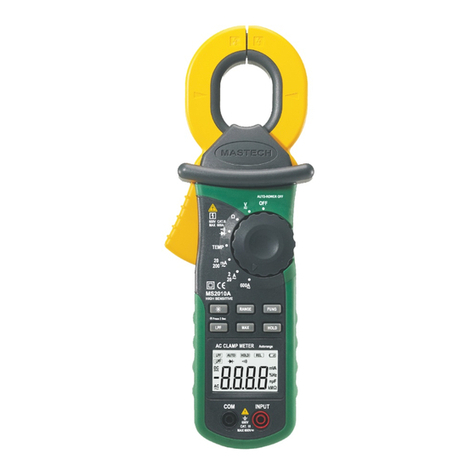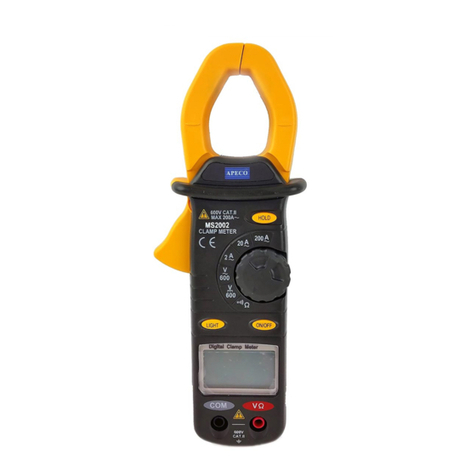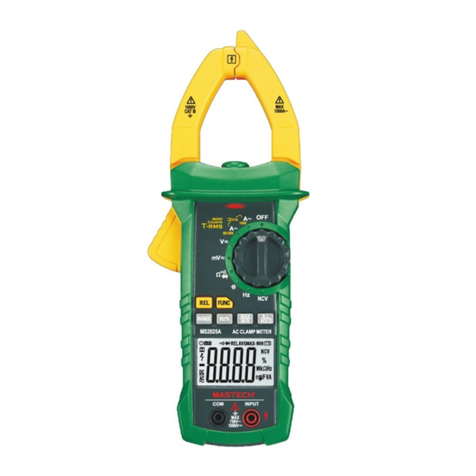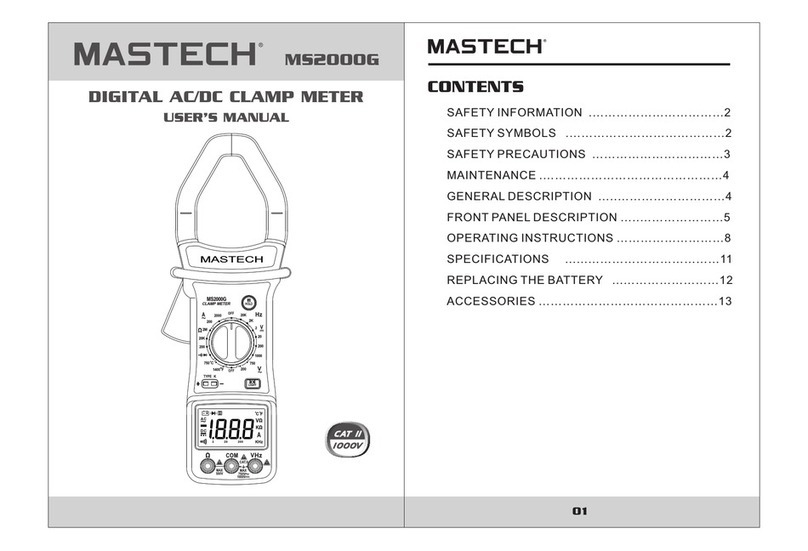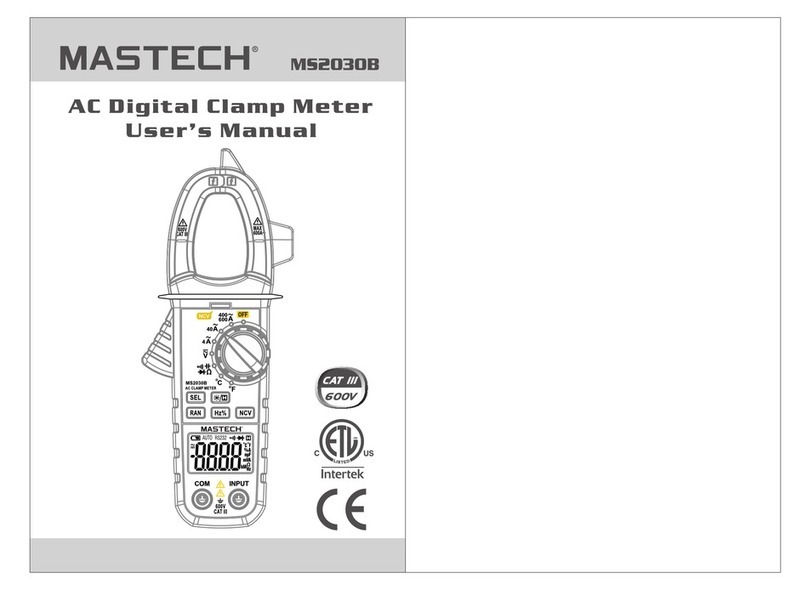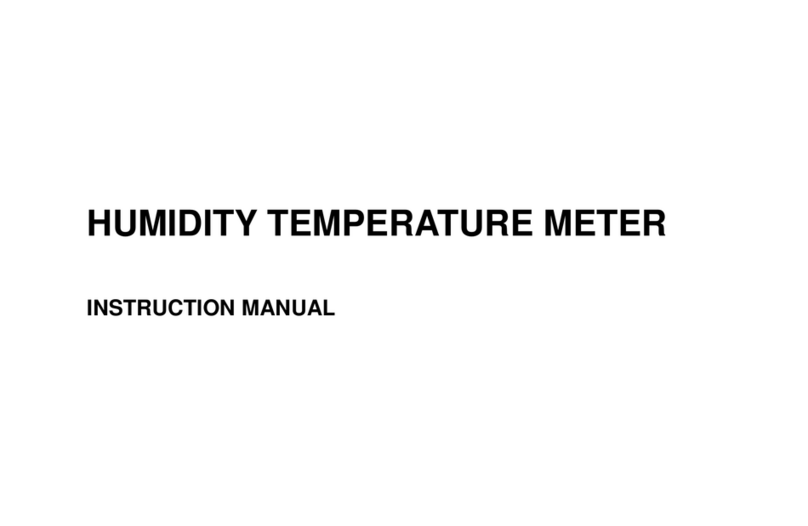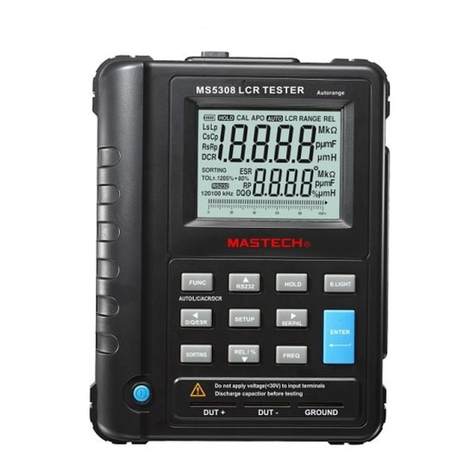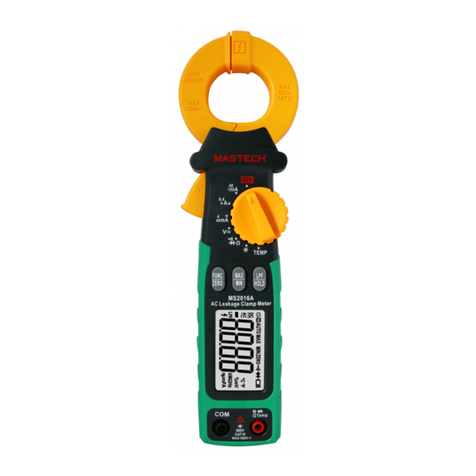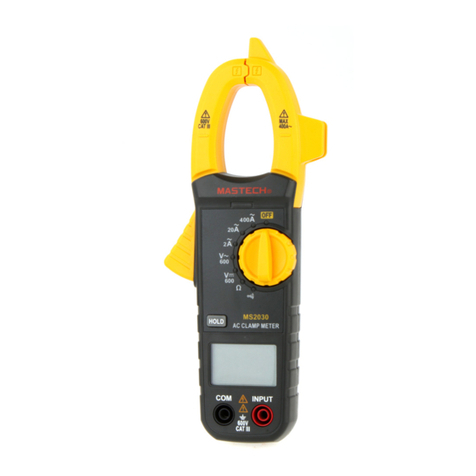Range Accuracy
Resolution
2V 1mV
20V 10mV
200V
±0.5% of rdg ±3 digits
0.1V
1000V ±0.8% of rdg ±3 digits
1V
Range Accuracy
Resolution
200V ±1.0% of rdg ±5 digits
0.1V
750V ±1.2% of rdg ±5 digits
1V
Range Accuracy
Resolution
±2.0% of rdg ±2 digits
±4.0% of rdg ±2 digits
±5.0% of rdg ±2 digits
Note
20MΩ
2000MΩ
1MΩ
1kΩ
>500MΩ
< 500MΩ
06 0 7
4.3 Insulatio n Test
(With option 500V insulation tester unit)
Input Impedance: 9M on all ranges
Overload protection: 1000V DC or 750V AC on all ranges
Frequency Range:(50Hz to 400Hz) /≤ 600V;
(50Hz to 200Hz) / 750V.
Response: Average, calibrated in rms of sine wave
≥Ω
Range Accuracy
Resolution
200Ω±1.0% of rdg ±5digits
0.1Ω
2kΩ1Ω
20kΩ
200kΩ
2MΩ
±1.0% of rdg ±8digits
10Ω
100Ω
1kΩ
Display
Terminals and
earth ground
Measuring Method
Overrange Indication
Polarity indication
Operating Temperature
Storage Environment
Power
Accessories
Low Battery Indication
Optional Accessories
Dimension
Weight
3 1/2 digit LCD,
with automatic polarity indication
1000V dc or 750V rms ac (sine)
“1” Figure only in the display
“-” displayed for negative polarity
0°C to 40°C (32°F to 104°F)
9V alkaline or carbon-zinc battery
(6F22 or equivalent )
Operating manual ,set of test leads
“BAT” to left of display
Thermocouple ( K type )
96(W) X 235(D) X 46(H) mm
330g( including battery )
Dual-slope integration A-D converter
-10°C to 50°C (14°F to 122°F)
3.6 Continuit y Test
1. Connect the black test lead to the COM jack and the
red test lead to the V jack. (The polarity of the red
lead is positive“ + ”)
2. Set the rotary switch at position and connect test
leads across two points of the circuit under testing.
If continuity exists (i.e., resistance less than about
100 ), built -in buzzer will sound.
Ω
Ω
10 1 1
Accuracy is specified for a period of one year after calibration
and at 18°C to 28°C (64°F to 82°F) with relative humidity
to 80%.
Frequency Range: 50Hz to 60Hz
Response: Average, Calibrated in rms of sine wave
Overload protection: 1200A within 60 seconds. Jaw Opening:
Ф50mm
HYS007039
2. When only the figure“1”displayed, it indicates overra nge
situation and the higher range have to be selected.
WRONG CORRECT
3.2 Insulatio n Test(O ption 5 00V insulation tester unit)
1. Connect the insulation tester unit VΩ, COM,
EXT thr ee-ba nana pl ugs to th e clamp m eter VΩ,
COM, EXT.
2. Set the rotary switch of clamp meter at 2000MΩ position.
3. Set the insulation tester unit range switch to the
2000MΩ position.
4. Uses the insulation tester unit of the test leads
connects its L, E input connect to being tested
installations. (Test in stall ation 's must b e power O FF)
5. Set the insulation tester power switch to the ON position.
6. Depress the PUSH 500V push-push switch; the 500V
on red LED lamp will light. Clamp meter display reading
is the insulation resistance value. If the reading is
below 19MΩ, change clamp meter and insulation tester
unit to 20MΩ range, can be increasing the accuracy.
7. If the insulation tester unit is not use, the power switch
must shift to power OFF position, and the test leads
must leave the E. L inp ut conn ect. That can be increase
battery life and prevent electrical shock hazard.
3.7 Measuring Temperatu re
1. Set the rotary switch at °C or °F position and the LCD
display will show the current environment temperature.
2. Insert “ K ” type thermocouple into the temperature
measuring socket on the front panel and contact the
object to be measured with the thermocouple probe.
Read LCD display.
WARNING:
To avoid electric shock, be sure the thermocouple has been
removed before changing to another function measuremen t.
3.8 Measuring F requency
1. Connect the black test lead to the COM jack and the red
test lead to the V jack.
2. Set the rotary switch at Hz position and connect test
leads across the source or load under measurement.
NOTE:
1. Reading is possible at input voltage above 10V rms.
but the accuracy is not guaranteed.
2. In noisy environment, it is preferable to use shield
cable for measuring small signal.
Ω
4. Specifications
4.2 AC Cu rrent
Range Accuracy
Resolution
200A
1000A
±2.5% of rdg ±5 digits
±3.0% of rdg ±10 digits
0.1A
1A
4.1 General
4.4 AC Voltage
4.5 Dc Volta ge
Input Impedance: ≥9M
Overload protection: 250Vrms AC for 200mV range,
1000V DC or 750V
Ω
AC for other range.
4.6 Resistanc e
Overload protection: 250V DC or 250Vrms AC on all ranges.
Open circuit voltage: 700mV
4.7 Frequency
08 0 9
Range Accuracy
Resolution
2kHz ±2.0% of rdg ±5digits
1Hz
5. Accessories
COME WITH THE CLAMP METER
Test Leads Model: T3000
Battery 9V 6F22 or equivalent
Operation Manual
6. Battery Replacement
If the sign“BAT”appears on the LCD display, it indicates that
battery should be replaced. Remove the battery cover of case.
Replace the exhausted battery with a new one.
WAR NING
Before attempting to open the battery cover, be sure that test
leads have been disconnected from measurement circuits to
avoid electric shock hazard.
WAR NING
Using this appliance in an environment with a
strong radiated radio-frequency
electromagnetic field (approximately 3V/m)
may influence its measuring accuracy.
3.3 Measuring Voltage
1. Connect the black test lead to the COM jack and the
red test lead to the V jack .
2. Set the rotary switch at the desired V or V range
position and connect test leads across the source or
load under measurement. Th e polar ity of th e red lea d
connection will be indicated along with the voltage
value when making DC voltage measurement.
3. When only the figure“ 1 ”is displayed, it indicates
overrange situation and the higher range has to
be selected.
Ω
1. Connect the black test lead to the COM jack and the
red test lead to the V jack .
2. Set the rotary switch at desired Ω position and connect
test leads across the resistor under measurement.
Note:
1. If the resistance being measured exceeds the
maximum value of the range selected or the input is
not connected, an overrange indication“ 1 ”will
be displayed.
2. When checking in - circuit resistance, be sure the
circuit under test has all power removed and that all
capacitors have been discharged fully.
Ω
3.4 Measuring R esistance
3.5 Testin g Diode
1. Connect the black test lead to the COM jack and the red
test lead to the V jack. (T he pola rity of r ed lead i s“ + ”)
2. Set the rotary switch at position and connect red
lead to the anode, black lead to the cathode of the
diode under testing. The met er will s how the a pprox .
forward voltage of the diode. If the lead connection is
reversed, only figure“ 1 ”displayed.
Ω

